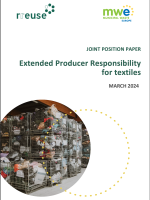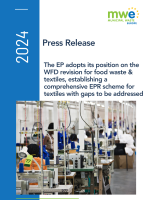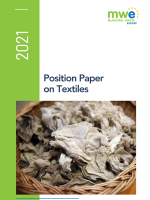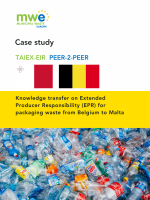MWE Position Paper on Extended Producer Responsibility for Textiles
In view of the upcoming adoption of the EU Strategy for Textiles and the Sustainable Product Policy in autumn of 2021, together with the regulatory mandate for Member States to collect textile waste separately by 2025, MWE welcomes the current discussions on Extended Producer Responsibility (EPR) as a potential instrument to promote a circular economy for textiles. As stated in our paper on the EU Strategy for Textiles, setting a separate collection target is not sufficient to close the textile materials loop. Further research and policy developments are urgently needed to achieve a circular economic model for textiles and reduce their environmental footprint.
MWE recognizes and welcomes the Policy Hubs' position on EPR, but we also indicate that EPR is not a silver bullet. More measures are needed in order to transform the textile industry and reach agreed sustainability goals. MWE believes that implementing an EPR scheme for textiles does not need to be the best solution in all EU Member States. There are examples in Europe where municipalities and their public municipal waste management companies have already taken a leading role by organising separate collection schemes and by developing sorting and recycling technologies and infrastructure for post-consumer textile waste (e.g. Finland).
Nonetheless, EPR could be a very helpful tool if well-designed. This can be achieved by taking the requirements set out in the Waste Framework Directive (2018) into serious consideration and the following:
1. EU minimum requirements for setting up EPR for textiles leaving flexibility to Members States.
A harmonised approach to EPR with a common European policy framework and guidelines are needed. These would include clear definitions (point 5), responsibilities, transparency, conditions for traceability and reporting and recommendations. However, EPR for textiles should not be compulsory and some flexibility is required so that Member States could adapt the tool to specific national circumstances.
2. Cooperation and transparency as key drivers for an efficient EPR scheme.
If an EPR system is due to be implemented for textiles in a Member State, this should be designed within a collaborative framework and with strong, transparent communication between all the players involved in the value chain and in the decision-making process (national/regional governments, municipalities and municipal waste operators, producers, retailers, sorters, recyclers, citizens, charities, social enterprises, research institutions, etc).
3. Waste hierarchy should be embedded in the decision-making process.
EPR schemes should help to move textiles away from landfilling and incineration and boost waste prevention, reuse and finally recycling. In this line, we call for an EU-wide ban on the destruction of unsold (and returned) goods, including textiles to discourage brand-owners, producers and retailers from this unsustainable and noncircular practice. In a normal year, Germany alone generates 1bn returned fashion items per year; this is two thirds of all sales and online sales during COVID increased this number which increases by a further 400% during Black Friday. Further to that, although we believe that EPR schemes should contribute to developing recycling solutions, the schemes should not prioritise recycling over waste prevention and reuse by driving reusable items directly to recycling streams. Measures should be taken to prevent this from happening.
4. Efficient traceability and commitment to phasing out of hazardous substances and substances of high concern.
In the development of an EPR scheme for textiles, attention should be given to the restriction of use of substances of very high concern. In this regard, it would be helpful to have a clear regulatory framework, paired with a strong commitment from the industry to phase out these substances. In particular, MWE requests that special attention and effort be given to preventing the release of microplastics into the environment.
5. Definition of textile, end-of-life textile, reuse and preparation for reuse.
The upcoming EU policy framework for textiles should include clear definitions of the above-mentioned terms and roles. A lack of clear definitions would lead to different national interpretations of the EU policy as experience with other legislation has shown. In the case of EPR, different interpretations can affect scope and create problems at collection and sorting stages as well as barriers to cross-border shipment, intra- and extraEU.
6. Definition of the scope of EPR for Textiles and the need for harmonisation across the EU.
It is important to determine at EU level which textile products fall under the scope of the Directive and related EPR scheme. MWE recommends that a clear definition and a harmonised scope for EPR for Textiles are adopted across the EU, so as to prevent economic and social disruptions and negative incentives. The textiles industry is taking an EU-wide approach to providing sufficient sorting and recycling capacity, something which we strongly support; this would require a unique understanding of definition and scope of EPR. Having the same scope in all Members States would make it easier for consumers to understand how and where to dispose of their used textiles (both waste and reusable items) anywhere in Europe. We recommend that at least post-consumer clothing is included in the scope initially, as current research and innovation is focused on the recycling of clothing textiles. The expansion of the scope however should not be much delayed. This should be expanded to include footwear and interior decoration textiles (bed linen, table linen, towels, carpets, curtains, furniture textiles, etc.) not only from households but also from the commercial/services sector (hotels, hospitals, retirement homes, etc.). In this context, our members are concerned about how the obligation for separate collection of textile waste by 2025 (even earlier in some EU Member States) will be applied. The concern pertains to the scope of the policy which should be aligned with the scope of EPR. It is important that whatever fractions of textile waste are collected, that the additional cost to municipalities of this separate collection are covered by the producer. It must be made abundantly clear that producer responsibility includes both coverage of the costs of collection and reception of the collected materials for recycling. Currently there is insufficient capacity for recycling of textiles within the EU. Targets and timelines must take this into account. MWE fully supports investments into an EU network of textile recycling plants to close this material loop within an EU circular economy.
7. Setting ambitious targets for waste reduction, collection, preparing-for-reuse, recycling and recycled content in new products.
If implemented, EPR schemes should be a tool for achieving the national targets concerning textiles, and thus, the producer or producer responsibility organizations (PROs) should integrate into their performance specific targets on waste reduction, collection, preparationfor-reuse, recycling rates as well as recycled textile content in new textile products. MWE underlines the importance of prevention measures to reduce consumption, innovate and replace 'fast fashion' business models, and thereby reduce the high volumes of new low-cost, low quality textiles entering the market.
8. Responsibilities and financial contributions of EPR schemes for textiles.
Operational responsibility for the collection of post-consumer textile waste should remain with municipalities insomuch as it is municipal waste and its collection is a service of general interest. Municipalities are also keen supporters of local and European partners and transparent operating models with regard to the creation or selection of repair, reuse and recycling solutions. EPR schemes for textiles need to be designed in such a way as to be inclusive of the textile waste collected and/or sorted by municipalities, charities and social enterprises as well as business to business activities.
Care must be taken to avoid free-riders and so ensure that each national EPR scheme applies to all producers, brands, distributors and retailers that put new textile products on the EU market, including imports and online sales.
Further to that, MWE believes that, if an EPR scheme for textiles is to be established in a Member State, EPR fees should financially contribute to:
✓ The collection of textile waste by municipalities and local public authorities. Producers (or PROs) should pay not only for the textile waste which is separately collected by municipalities but also for the share of textile waste that ends up in the residual waste and thus, goes into incineration and landfilling. In other words, EPR fees should cover the infrastructure, transport, necessary training and end-of-life treatment of the textile waste which remains in the residual stream as well. If not, the EPR system would not be fulfilling the extended producer responsibility of its members.
✓ Boost research and innovation in ecodesign in accordance to the waste hierarchy principle and the United Nations Sustainable Development Goals (UN SDGs) and aim at encouraging producers to become involved in the eco-modulation criteria suggested by MWE later on in this document.
✓ Increase sorting and recycling capacity by investing in technological solutions.
✓ Boost circular business models based on the UN SDGs, a strong commitment to manufacture high quality textile products and to discourage 'take-make-use-throw' mind-sets and fast fashion trends.
✓ Communication campaigns at national/regional/local level addressed to citizens/consumers in collaboration with the public authorities in order to increase separate collection of textile waste and build a positive perception towards second-hand textile products and repair services.
9. Ecodesign and eco-modulation criteria: boosting the production of quality textiles and fibre-to-fibre recycling.
MWE proposes to explore the following five criteria for the eco-modulation of EPR fees for textiles:
✓ Durability. Designing products to last as long as possible should be embedded in the design stage. Textile products should be designed to last in good conditions as long as possible regardless of fashion trends as this would foster waste prevention/reduction and the use of second-hand items. There used to be 4 fashion seasons per year. Now there are no seasons as trends are continuously re-set causing exponential consumption of cheap, socially and environmentally irresponsible items.
✓ Repairability/'refurbishability'. Textiles should not be only durable but also smartly designed to boost their potential to be repaired. For example, replacing glue at the design phase with different assembly methods. This would incentivise repair services and increase jobs for reparability and preparation-for-reuse solutions.
✓ Circular business models. Incentives for repair and reuse models should be included. For example, by extending and making more easily accessible guarantee periods for consumers than required by national law. Brands and retailers can further facilitate this by cooperating with socially responsible repair and reuse organisations and networks. This would initiate a discussion on circular business models and would contribute to reducing risks of green washing.
✓ Recyclability. Textiles should be made to be recyclable when repair and reuse are no longer a solution. Non-recyclable textiles currently end up in incineration and landfilling, removing these materials from the circular economy.
✓ Recycled content. Textile products manufactured by incorporating secondary raw materials obtained from the recycling process of used textile products should also be rewarded. MWE would like to explicitly emphasise that recycled content should only include secondary textile materials as we are of the opinion that recycled plastic content from other waste streams (e.g. PETs) does not contribute to a circular economy, neither for textiles nor for plastics. Incentivising the manufacture of textiles with high plastic content is not a solution but only contributes to the release of microplastics into the environment. As stated in the MWE position paper on the EU Textiles Strategy, EU policymakers should take measures to foster a market for recycled textile materials, looking at textiles as a resource and no longer as waste.
✓ Environmental & social assessment. This would include carbon footprint, prevention of hazardous substances in the products for human health and environment, prevention of the use of substances that prevent recycling, repair and reuse, social responsibility and the prevention of microplastic release during the whole life-cycle of the product, to mention just a few relevant points.
In addition to the above, we invite you to take into account MWE's position paper on EPR2 in the context of the revision of the Waste Framework Directive in 2013, which goes into further detail on how an EPR scheme should be designed, as well as the recently published MWE response to the public consultation on the Sustainable Product Policy Initiative. Both of these documents can be requested from our Secretariat or on our website.




